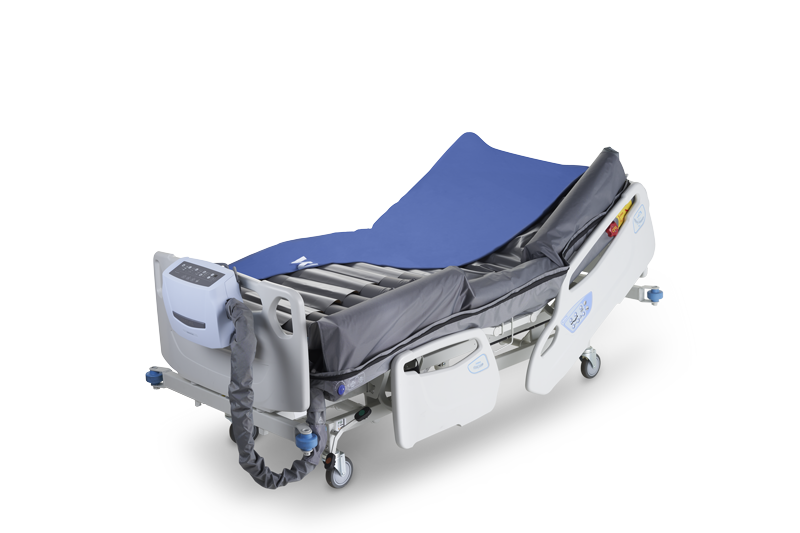Optima Auto
Alternating Pressure and Low Air Loss System with Automatic Pressure AdjustmentFor High to Very High Risk
Reducing pressure injuries for long-term care — Increasing skin activity and improving blood circulation with alternating pressure.
On average, 65 per 1000 adult inpatients develop pressure injuries (also known as pressure ulcers) and require 18 in-hospital days. That's 2.5 times that of an average acute inpatient. Financially, treating PU sets families back by USD 15,700 to USD 17,700. Since 87% are elderly patients, an ageing population and COVID-19 accelerates PU prevalence, exhausting global human, material, and capital reserves.1
Optima Auto provides caregivers more control and personalization over air mattress firmness, an elementary air pump interface suitable for all levels of caregivers, and a backup power system for maintaining pressure distribution up to 6 hours. Preventing pressure injuries improves patient outcomes and patient care experience.

Prepared for intensive compression care
- Proprietary automatic pump optimizes mattress pressure settings to patients' weight distribution for fast pressure relief.
- Structurally reinforced air cells in the sacrum area improves structural support for comfy sitting and in-bed movements.
- Built-in battery (optional) ensures non-stop alternating pressure relief up to 6 hours for securing transportation or power failures.
- Visual interface with LCD simplifies controls, indicators, settings, and power functionalities for all levels of caregivers to use.
- A noise-sensitive pump ensures stressed patients and caregivers recover and work in a comfortable and safe environment.

Pump's auto-detection and initiation simplify caregivers' workflow in quickly providing optimal pressure relief care.

Sacrum area automatically inflates to optimal firmness once the head section of the mattress rises above 30°.

Continuous pressure relief care during transport ensures uninterrupted therapy outcomes and patient comfort.

Intuitive pump interface and low-noise levels allow caregivers to deliver care and comfort throughout the day consistently.
| Mattress Dimension (L x W x H ) | 78.7 x 36 x 8 in |
|---|---|
| Mattress Weight | 28.6 lb |
| Maximum Patient Weight | 550 lb |
Pump Dimension (L x W x H) |
13.4 x 6.5 x 10.2 in |
| Supply Voltage | 110-120 V / 60 Hz |

Prepared for intensive compression care
- Proprietary automatic pump optimizes mattress pressure settings to patients' weight distribution for fast pressure relief.
- Structurally reinforced air cells in the sacrum area improves structural support for comfy sitting and in-bed movements.
- Built-in battery (optional) ensures non-stop alternating pressure relief up to 6 hours for securing transportation or power failures.
- Visual interface with LCD simplifies controls, indicators, settings, and power functionalities for all levels of caregivers to use.
- A noise-sensitive pump ensures stressed patients and caregivers recover and work in a comfortable and safe environment.

Pump's auto-detection and initiation simplify caregivers' workflow in quickly providing optimal pressure relief care.

Sacrum area automatically inflates to optimal firmness once the head section of the mattress rises above 30°.

Continuous pressure relief care during transport ensures uninterrupted therapy outcomes and patient comfort.

Intuitive pump interface and low-noise levels allow caregivers to deliver care and comfort throughout the day consistently.
All air cells are made from Thermoplastic Polyurethanes (TPU). It is highly resistant to breaking down when in contact with water (hydrolysis), soft to touch, and minimizes friction and noise during patient movements.
Cell-in-cell design refers to encapsulating a firm air cell within a larger outer cell, doubling the effect of firmness and stability for patients. Wellell’s Optima Series, including Auto, uses air cells with the cell-in-cell design in the sacrum area to improve patient support and comfort during sitting positions and when patients leave and enter the bed.
Optima Auto's pressure relief solution divides into 3 zones: head, torso, and Lower leg. During care, each zone provides optimal pressure redistribution, immersion, and envelopment based on the weight of the body part, improving stability and comfort for patients of all body types.
Reference
- Lo, Zhiwen J et al. “Clinical and economic burden of wound care in the tropics: a 5-year institutional population health review.” International wound journal vol. 17,3 (2020): 790-803. doi:10.1111/iwj.13333.








